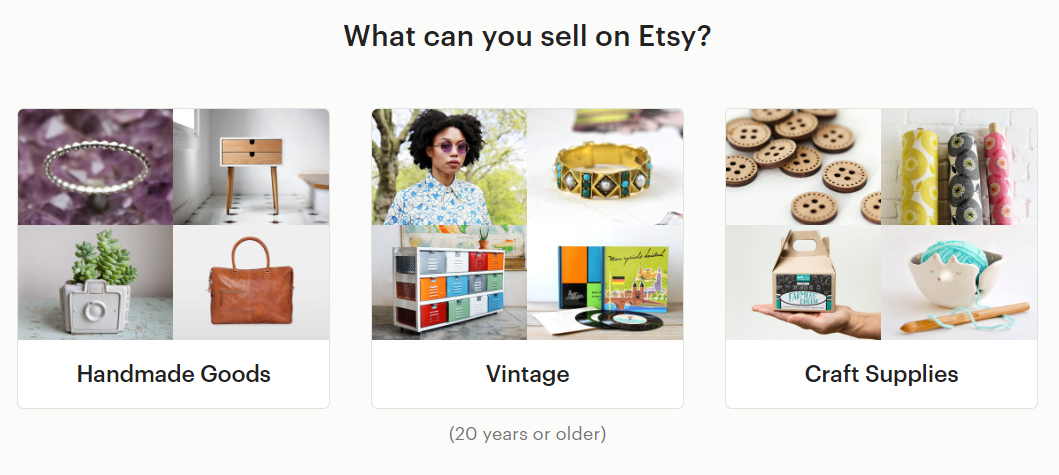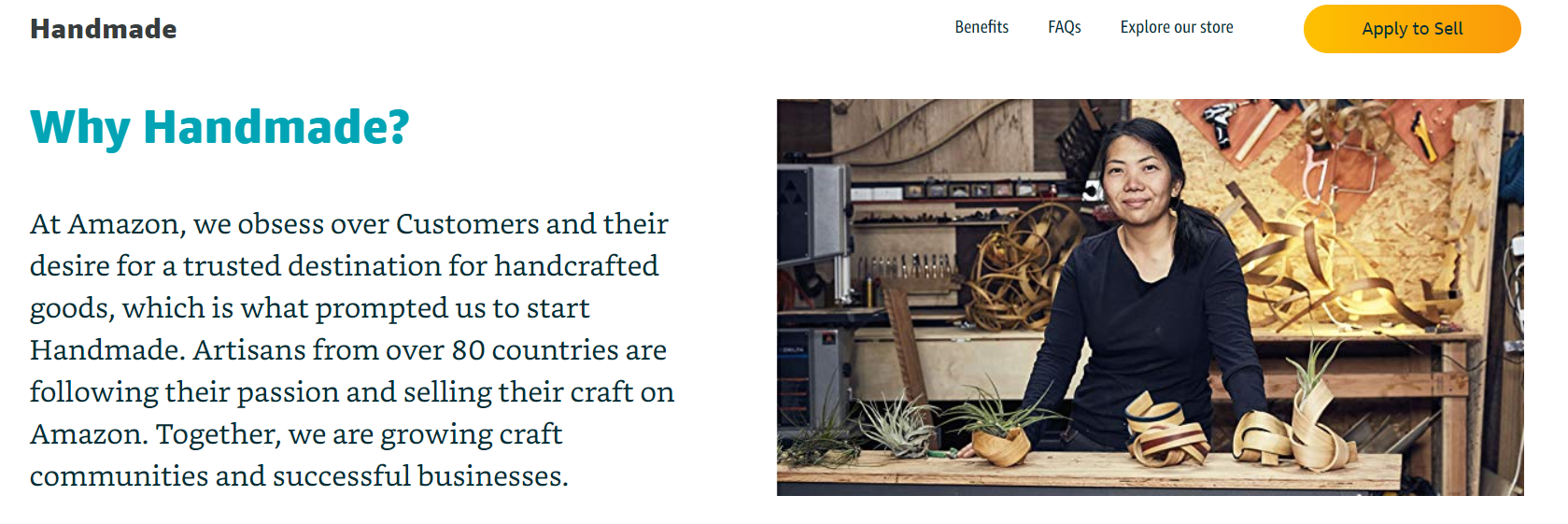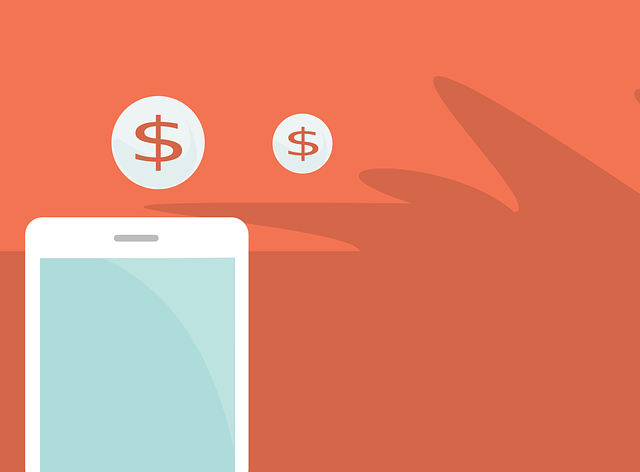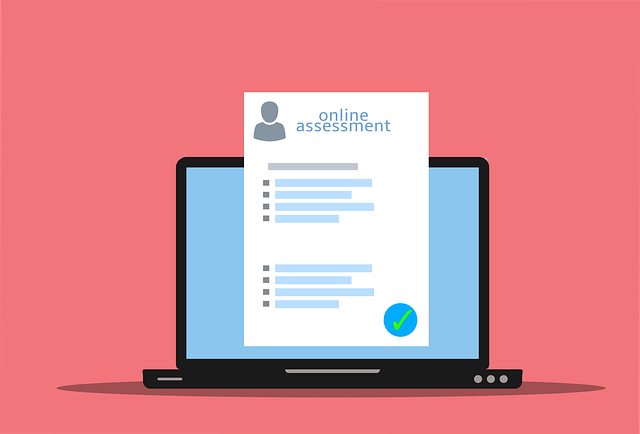The 9 Best Etsy Alternatives To Help Power Your Online Store
By 2021, Ecommerce sales are predicted to reach 17.5% of retail sales. The trend of online sales carving into traditional retail channels isn't new, and it's undeniable that online sales are going to continue to grow moving forwards.
One industry that has undoubtedly seen a boom thanks to the power of ecommerce is the vintage and handmade market.
Ecommerce platforms have given creative artists the ability to sell their handmade and vintage items, and this provides artists and craftsman a new outlet to sell their wares.
Etsy, an extremely popular platform in this space, has been growing since 2005, with the focus of becoming the largest platform to satisfy creative minds. Chances are, if you've ever shopped online for artisanal crafts, you've visited Etsy.
However, popularity in an e-commerce site also means a high saturation of artists trying to sell their merchandise. If you've ever tried selling on Etsy, perhaps you found it difficult to separate yourself from the crowd.
Luckily, there are many other Etsy alternatives that allow aspiring artisanal sellers to find a competitive advantage and less saturated marketplaces.
If you’re a seller currently struggling with generating sales on Etsy, this list of Etsy alternatives is the perfect list to check out.
But first, let’s find out what the largest platform for handmade and vintage items has to offer…
What is Etsy?
Etsy is an e-commerce site headquartered in Brooklyn, New York and was created in 2005. Etsy's goal is to allow buyers and sellers to connect over handmade, vintage, or craft supply items.
Unlike more generic online marketplaces such as Ebay, Etsy gives creative artists a chance to have a presence on a large selling marketplace that is solely dedicated to handcrafted and vintage items.
Some sellers have been able to use Etsy as their full time job, or at the very least, to make some side income.
In fact, Etsy has over 2.5 million sellers as of 2019, and allow over 40 million buyers to get handmade gifts. On average, Etsy businesses contribute 12% of a household's total income, so there's definitely a lot of money on this platform.
Why Sell on Etsy?
Etsy is undeniably the king of online artisanal goods. Despite market saturation, there's a reason many sellers turn to this platform and ignore the plethora of Etsy competitors out there.
So, let’s break down a few pros and cons of selling your items on Etsy and why sellers choose this platform:
Pros of Selling on Etsy
The main draws to using Etsy to sell your wares include:
- Large existing audience.
- Cheaper than selling directly to consumers at craft shows.
- Useful analytics for your listed items.
- Easy to list new items and to grow your store.
- Ability to use ads to power traffic.
Cons of Etsy selling
- Saturated market.
- Requires significant of promotional work to grow your shop.
- Getting noticed requires decent inventory.
- Selling fees add up quickly and items expire in your shop.
Depending on what you want to sell, Etsy may or may not be for you. The market is very saturated, but the being on the first or second page can drive you tons of sales.
You should do your research before deciding if this is the right platform to get started with. If you think Etsy work for you, then perhaps these sites like Etsy will!
Top Etsy Alternatives
If you have a product that doesn’t fit on Etsy’s marketplace or want to tap into less competitive markets, consider these 8 other Ecommerce platforms to sell on instead!
1. IndieMade
IndieMade provides artists a way to create simple websites in order to sell products through their own platform.
Not only does this help artists create a name for themselves, but it also helps take away the saturation of large Ecommerce platforms like Etsy. With IndieMade, you can create a beautiful website with a store, blog, shop, and more!
Here’s how IndieMade works:
- Sign up for a 30 day free trial.
- Design your storefront in minutes.
- Start listing your products.
That’s it! You can honestly start a full blown website with pictures, articles, products, and everything in a few simple steps.
In terms of pricing, IndieMade ranges from $4.95 to $19.95 per month depending on your plan.
For most sellers, a basic or standard plan will suffice, unless you want to sell more than 100 products or offer electronic files.
IndieMade was created by artists who wanted to be seen but didn’t want to struggle with the hassle of creating their own website from scratch. Plus, IndieMade doesn't take any cuts from your sales!
The Pros: You get your own custom domain and website with any plan except the basic plan. Easy to setup and sell.
The Cons: If you are serious about selling, you'll probably need more than a basic plan, which means spending money right out of the gate.
IndieMade Cost: $4.95 to $19.95 per month, probably $12.95 at least for most sellers.
2. Amazon Handmade
Surprise! Amazon has a section for handmade stuff too.
Amazon Handmade has 2 main requirements in order to start selling with them:
- Your products must be made by hand.
- Must be handmade by you or employees (less than 20).
Aside from that, your items must be in any of the following categories:
- Home products.
- Jewelry.
- Beauty and personal care.
- Pet supplies.
- Party supplies,
- Stationery.
- Baby products.
- Sporting goods.
- Toys and games.
Amazon Handmade takes a 15% commission, which can be very high for solo sellers who have a limited supply of products.
Plus, your products will only be listed in the Handmade section, meaning you can’t go to Amazon’s homepage and find your product.
However, this is an effective way to make money on Amazon and to diversify your online sales channels compared to just using Etsy. Plus, given Amazon's track record, I wouldn't be surprised if Amazon Handmade grows year over year.
Keep these factors in mind when deciding on an alternative. Clearly, Amazon wants to separate themselves from Etsy by making their products “handmade only”.
The Pros: Set fees and very easy to get started.
The Cons: You don't own your own website as you would with a site like IndieMade, and time will tell how large this platform will become.
Amazon Handmade Cost: 15%..
3. Zibbet
What separates Zibbet from its competition is actually the fact that there isn’t any competition. Zibbet wants you to sell as much as you can!
That’s why their platform allows you to sell on multiple websites, including Etsy.
Here’s how it works:
- Create an account with Zibbet.
- Pay $5/month per channel you connect.
- List your product through Zibbet.
- Your products will then be available on multiple platforms.
A sales channel is basically one platform to sell on (Etsy, Zibbet Marketplace, A.C Moore Marketplace, and Stich). If you want to sell on all 4 of these sites for example, that would cost you $20/month.
Just note, Zibbet requires a minimum of 2 sales channels, or $10 per month.
Plus, Zibbet doesn't cover external platform fees, such as Etsy's $0.20 per listing fee.
Keep in mind that $10 to $20 a month is giving your products the potential to triple in sales! This can be very worth it for people who would prefer to test out multiple channels and don't mind paying a monthly fee.
The Pros: Simple way to expand your reach for only $10 to $20 per month.
The Cons: You still have to put effort in to grow multiple channels. More is not always better.
Zibbet Cost: $10 to $20 per month plus external selling fees (where applicable).
4. Storenvy
Storenvy is an online marketplace that's also one of the most popular sites like Etsy. Plus, Storenvy also uses a lot of on-platform promotion to help highlight sellers. Here’s how it works:
- Build your free online store.
- Join the Marketplace.
- Upload your products in minutes.
- Connect Paypal or Stripe to process payment.
- Promote your business.
Storenvy gives sellers the opportunity to do their selling and promoting in one place.
Plus, this social network is already looking for the types of things you’re selling! Storenvy has a trending section and Editor's Pick section that help push awesome sellers to the front page to boost sales.
Sellers pay a 15% commission, including shipping costs. There are no other fees.
Storenvy has a variety of paid store options, as well as a free plan. However, you honestly get a lot out of the free plan, and I recommend starting with this option to test out selling on Storenvy:
Although Storenvy doesn’t aggressively monitor what types of products are posted on their marketplace, the following categories tend to do better than others:
- Clothing.
- Art.
- Jewelry.
- Beauty.
- Kids products and games.
- Home goods.
There are other categories, but be sure to do some research before deciding if your product would fit well on Storenvy.
The Pros: Simple way to start selling without paying upfront fees. Getting promoted would also boost your store.
The Cons: Still have to rely on external promotion and to work to optimize your shop to show in organic listings.
Storenvy Cost: $0 to $29.99 per month plus 15% commission on sales.
Extra Reading – How to Avoid PayPal Fees & Maximize Income.
5. Bonanza
Bonanza has become one of the best Etsy alternatives over the years and for good reason. After all, the site goes by the slogan ‘find everything but the ordinary,' so it's definitely a stellar hub for artisanal goods.
Here’s what Bonanza has to offer:
- Free listings.
- 3.5% commission on sales ($0.50 minimum).
- Integration with Google shopping.
- Easy product importing from other websites (Amazon, Etsy, Shopify, Ebay, or an inventory file).
- A much less saturated market than sites like Etsy.
Bonanza has buyers mainly interested in the same things as Storenvy. You can really find/sell anything you can think of, which has helped it stand out from Etsy and other e-commerce platforms that focus on vintage and crafts.
You can start your own website through Bonanza with a click of a button and gain access to great features like Background Burner.
You can also just list your items on the Bonanza marketplace as you would on the Etsy marketplace, so it's the best of both worlds.
Bonanza's Background Burner software also clears out your product background and makes listings look like they photographed in a studio, which is an exceptional feature since product images can make or break a sale.
If you want an Etsy alternative that is affordable and easy to setup, I definitely recommend checking out Bonanza.
The Pros: Pretty much an Etsy clone but less saturated and very affordable.
The Cons: Organic marketplace is still competitive, so you'll really have to optimize your listings and work to grow your account.
Bonanza Cost: 3.5% commission.
6. ArtFire
Artfire is an online boutique-style marketplace that allows independent artists and small businesses from around the world to sell their wares online.
Similar to Etsy, you can sell handmade, vintage, and craft items on ArtFire.
Here’s how it works:
- Make an account.
- Choose a plan.
- List your items.
- Grow your store.
There are 3 basic plans to choose from for ArtFire sellers:
- Standard ($4.95/month).
- Popular ($20/month).
- Featured ($40/month).
The “Popular” plan seems to be the most bang for your buck, but it obviously depends on your needs.
ArtFire gives you everything you need including special features like professional website design, easy selling management, friendly support, and thousands of customers every month.
The Pros: Unique marketplace with a decent search engine, so your shop can appear organically if you work at it.
The Cons: The basic plan is pretty steep in terms of listing fee, monthly fee, and commission.
ArtFire Plans: See plan list above.
7. Zazzle
Ever thought of starting a creative store without actually handling the manufacturing or shipping of products? Well, Zazzle allows you to do exactly that!
If you ever read WebMonkey's Etsy POD Dropshipping experiment, you'll know exactly how Zazzle works.
With Zazzle, you literally just design images or logos on already made products and then sell them! There's no need to worry about manufacturing or shipping, which is the beauty of the print-on-demand model.
Here are a few of the things you can design and sell on Zazzle.
- Shirts.
- Pillows.
- Mugs.
- Wall Decor.
- Office Supplies.
- Sports Equipment.
- Electronics/Accessories.
All you have to do is click “start creating” on their website and you’re already halfway done!
You set your own royalty rates with a minimum of 5% all the way up to 99%. Once you sign up, you can start designing in minutes!
Of course, you can still create products and sell them on this platform, but I think Zazzle is really worth it if you’d rather use their designing features and make use of how easy POD is.
If you decide to become an actual seller on the platform with your own products, Zazzle takes a 30% commission per sale.
The Pros: Zazzle is a leading POD marketplace, and you don't have to deal with manufacturing or logistic headaches.
The Cons: POD stores usually have lower profit margins than handcrafted operations since you have to pay the manufacturer a hefty share.
Zazzle Pricing: Depends on the royalty percentage you set.
Extra Reading – The Best Websites Like Zazzle.
8. Folksy
Do you live in the UK? If the answer is yes, then I may have just found the perfect site like Etsy for you.
Folksy is a UK marketplace that is perfect for handy creators trying to sell their creations.
Unfortunately, you can’t sell anything on Folksy if you don't live in the UK. But, if you do live in the U.K, here’s are the main facts to know about Folksy:
- 6% commission.
- 2 main plans (15 pence to 5 pounds/month).
- 25+ selling benefits.
- Personalized store url included.
- Focus on British Crafts.
Some of the Folksy’s selling benefits include no setup fees, Instagram shopping tags, over 9 million unique monthly viewers, and a free ecourse to help you sell faster!
Ultimately, Folksy can really go 2 ways for you.
You either just found the jackpot Etsy alternative that you needed or you don’t live in the UK and none of this applies to you. Hopefully, it's the former!
The Pros: This is an amazing option for UK based sellers due to the exclusivity and massive monthly traffic. Also fairly affordable.
The Cons: UK requirement.
Folksy Pricing: Depends on the plan you select.
9. Big Cartel
Big Cartel is another popular alternative to Etsy that's popular if you sell physical products and want control over your own storefront.
Big Cartel lets you set up your own ecommerce store without having to know how to code.
The platform has numerous, minimalist themes you can use for your shop, and popular products to sell from a Big Cartel store include:
- Apparel
- Accessories
- Artwork
- Jewelry
- Pottery
Unlike Etsy, Big Cartel also has a free plan that lets you upload up to five products.
You can also pay for monthly plans if you want to sell more products and unlock a few features. Big Cartel doesn't charge transaction fees like Etsy either.
You still have to factor in payment processing fees from Stripe or PayPal, but overall, Big Cartel is an affordable and easy-to-use ecommerce platform.
The Pros: A free plan is available and Big Cartel doesn't charge transaction fees.
The Cons: You can't sell digital products.
Folksy Pricing: Free but upwards of $19.99 per month depending on how many products you sell.
Extra Reading – Big Cartel vs Etsy – What's Best For Sellers.
When Should You Consider Etsy Alternatives?
I don't want to knock Etsy too hard since it is a leading online marketplace for handmade goods, art, vintage wear, clothing, and other artisanal goods.
However, if you're considering using another site like Etsy, here is what you should consider.
First, you should take a look at what specific product you sell and what your future selling goals are.
If you’d rather focus on creating handmade products and want to sell them to the largest possible market, then you should probably stick to Etsy. Just note that it will be a grind to build up your store's reputation and organic visibility.
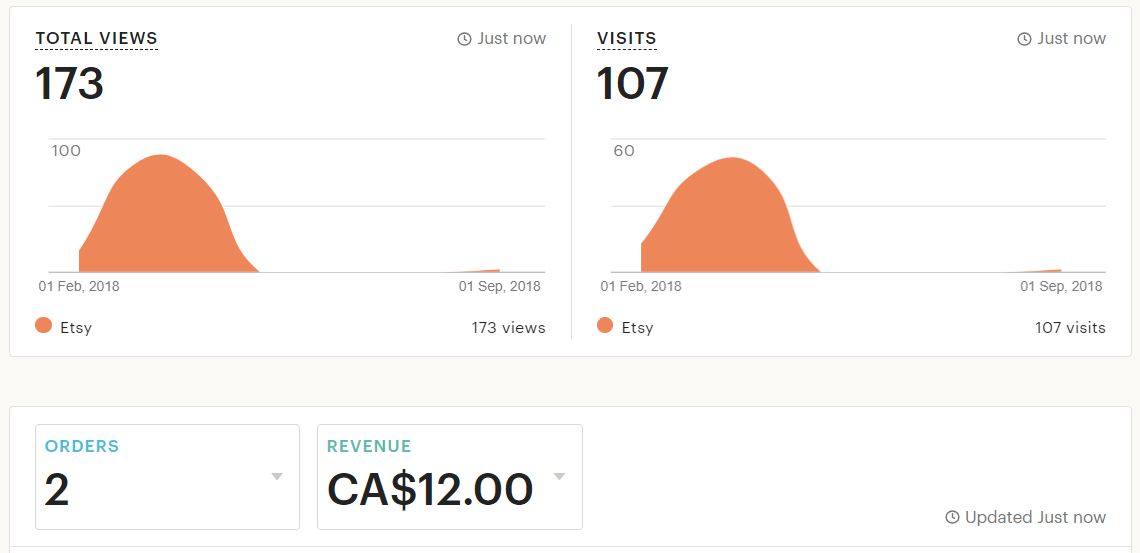
However, if you’d rather sell in a less competitive marketplace or want to try multiple channels, then consider switching to another competitor.
Your future selling goals have a lot to do with what platform you end up choosing. Write down your goals, needs, or any other selling factors and determine how the sites like Etsy can be to your advantage.
From what I’ve seen, it seems that artistic creators who don’t want to deal with the business side of things are leaning more towards Etsy, while other creators who want to grow their presence on their own will lean towards various Etsy alternatives.
Ultimately, this decision is up to you, but at least you have the information to work with now!
Extra Reading – How To Make Money Selling Stickers On Etsy.
Final Thoughts
No matter what platform you choose to sell on, there’s no doubt that we have such an incredible opportunity in the world to make money online.
If you’re just starting on your creative entrepreneurial journey, I hope this article has helped you jumpstart in the right direction.
There are plenty of options to choose from which may seem scary at first, but some of the differences are subtle and will ultimately be a small factor in your decision making.
Etsy isn’t for every creative artist, and that’s okay! Whatever you choose should be for your own needs and interests. Keep those factors in mind when deciding on your ideal selling marketplace.
And if you can’t find the right one for you right away, you can always make the switch to another platform with ease.



